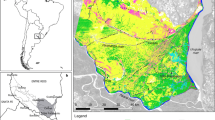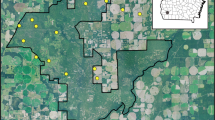Abstract
Many wetland-dependent birds are thought to be experiencing significant population declines, although population trend data for this suite of birds are rare and the causes of declines poorly understood. We used a 26-year dataset (1980–2005) of wetland bird abundance and distribution among 196 wetlands in northeastern Illinois (i.e., Chicago and its suburbs) to evaluate population trends and identify underlying ecological causes. We used aerial photography and GIS to quantify wetland habitat structure (i.e., the extent of emergent vegetation) and changes in surrounding land use. We then evaluated how changes in land use affected the structure of wetlands and ultimately wetland bird populations. Of the 12 species analyzed, seven experienced significant declines, three showed non-significant declines, and two experienced significant increases. Population declines could not be attributed to wetland loss because none of our wetlands were destroyed. Concurrent research at these wetlands also suggests that neither low adult survival nor poor reproductive success were responsible for the declines. Increased development within 2 km of wetlands, however, was associated with extreme changes in the structure of wetlands. Wetlands tended either to lose much of their vegetation and become open ponds, or become rank stands of dense vegetation. Both changes made wetlands less suitable for many wetland birds. While “no net loss” legislation may protect wetlands from being filled or drained, development near wetlands appears to be altering hydrology, resulting in habitat degradation and population declines of several wetland-dependent bird species.





Similar content being viewed by others
References
Arnold TW (1994) A roadside transect for censusing breeding coots and grebes. Wildl Soc Bull 22:437–443
Baker BW, Cade BS, Mangus WL, McMillen JL (1995) Spatial analysis of sandhill crane nesting habitat. J Wildl Manage 59:752–758
Bibby CJ, Burgess ND, Hill DA, Mustoe S (2000) Bird census techniques. Academic Press, New York
Buckland ST, Anderson DR, Burnham KP, Laake JL (1993) Distance sampling: estimating abundance of biological populations. Chapman and Hall, London
Burnham KP, Anderson DR (2002) Model selection and multimodel inference: a practical information-theoretic approach, 2nd edn. Springer, New York
Ciaranca MA, Allin CC, Gwilym SJ (1997) Mute Swan (Cygnus olor), The birds of North America Online. In: Poole A (ed) Cornell lab of ornithology. Ithaca
Conway WC, Eddleman WR, Anderson WC (1994) Nesting success and survival of Virginia Rails and Soras. Wilson Bull 106:466–473
Desgranges J, Ingram J, Drolet B, Morin J, Savage C, Borcard D (2006) Modeling wetland bird response to water level changes in the lake Ontario—St. Lawrence River hydrosystem. Environ Monit Assess 113:329–365
Faulkner S (2004) Urbanization impacts on the structure and function of forested wetlands. Urban Ecosyst 7:1573–1642
Findlay CS, Bourdages J (2000) Response time of wetland biodiversity to road construction on adjacent lands. Conserv Biol 14:86–94
Geissler PH, Sauer JP (1990). Topics in route-regression analysis. Survey designs and statistical methods for the estimation of avian population trends. In: Sauer JP, Droege S (eds) US Fish and Wildlife Service Biological Report 90
Gibbs JP, Melvin SM (1993) Call-response surveys for monitoring breeding waterbirds. J Wildl Manage 57:27–34
Heidorn RR, Glass WD, Ludwig DR, Cole MAR (1991) Northeastern Illinois Wetland Survey for Endangered and Threatened Birds: a summary of field data 1980–1989. Natural Heritage General Technical Report #1. Illinois Department of Conservation, Springfield, IL
Heimlich RK, Wiebe R, Claassen D, Gadsby D, House R (1998) Agriculture and wetlands: is “No Net Loss” achievable. Economic Research Service/USDA, Agricultural Outlook Retrieved Nov. 1, 2008 from http://www.ers.usda.gov/publications/agoutlook/jun1998/ao252e.pdf
Herkert JR (1995) Analysis of Midwestern breeding bird population trends 1966–1993. Am Midl Nat 134:41–50
Kercher S, Carpenter QJ, Zedler J (2004) Interrelationships of Hydrologic Disturbance. Reed Canary Grass (Phalaris arundinaces L.), and Native Plants in Wisconsin Wet Meadows. Nat Area J 24:316–325
Littell RC, Milliken GA, Stroup WW, Wolfinger RD, Schabenberger O (2006) SAS for mixed models. SAS Institute, Cary, NC
Lor S, Malecki RA (2002) Call-response surveys to monitor marsh bird population trends. Wildl Soc Bull 30:1195–1201
Lor S, Malecki RA (2006) Breeding ecology and nesting habitat associations of five marsh bird species in western New York. Waterbirds 29:427–436
Miller RC, Zedler JB (2003) Responses of native and invasive wetland plants to hydroperiod and water depth. Plant Ecol 167:57–69
Mitsch WJ, Gosselink JG (2000) Wetlands. Wiley, New York
Murkin HR, Murkin EJ, Ball JP (1997) Avian habitat selection and prairie wetland dynamics: a 10-year experiment. Ecol Appl 7:1144–1159
Niemuth ND, Solberg JW (2003) Response of waterbirds to number of wetlands in the prairie pothole region of North Dakota, USA. Waterbirds 26:233–238
Owen C (1999) Hydrology and history: land use changes and ecological responses in an urban wetland. Wetland Ecol Manage 6:209–219
Paine CP (1997) Abundance and nesting productivity of wetland-dependent birds in northeastern Illinois. Final Project Report for the U.S. Fish and Wildlife Service # 14-48-009-95-1276
Peterjohn BG, Sauer J (1997) Population trends of Black Terns from the North American Breeding Bird Survey, 1966–1996. Colon Waterbird 20:566–573
Rehm EM, Baldassarre GA (2007) The influence of interspersion on marsh bird abundance in New York. Wilson J Ornithol 119:648–654
Reinhelt L, Horner R, Azous A (1998) Impacts of urbanization on palustrine (depressional freshwater) wetlands—research and management in the Puget Sound region. Urban Ecosyst 2:219–236
Robbins CS, Bystrak D, Geissler PH (1986) The breeding bird survey: its first fifteen years, 1965–1979. U.S. Fish and Wildlife Service. Publication 157
Sauer JR, Hines JE, Fallon J (2008) The North American Breeding Bird Survey, Results and Analysis 1966–2007. Version 5.15.2008. USGS Patuxent Wildlife Research Center, Laurel, MD
Southern WE, Brown MW, Houchens TL, Southern LK (1981) Northeastern Illinois wetland inventory: Cook, DuPage, Kane, Lake, and McHenry Counties. Illinois Department of Conservation, Springfield, IL
Spyreas G, Ellis J, Carroll C, Molano-Flores B (2004) Non-native plant commonness and dominance in the forests, wetlands, and grasslands of Illinois, USA. Nat Area J 24:290–299
van der Valk AG (2005) Water-level fluctuations in North American prairie wetlands. Hydrobiologia 539:171–188
Ward MP (2005) The role of immigration in the decline of an isolated migratory bird population. Conserv Biol 19:1528–1536
Weller MW (1999) Wetland birds, habitat resources and conservation implications. Cambridge University Press, London
Weller MW, Spatcher CS (1965) Role of habitat in the distribution and abundance of marsh birds. Iowa Agricultural and Home Economics Project 1504, pp 5–31
Wright TJ, Tomlinson T, Schueler T, Cappiella K (2006) Direct and indirect impacts of urbanization on wetland quality. In: Schueler T, Holland H (eds) Wetlands and watersheds. Center for Watershed Protection, Elliot City, MD
Acknowledgments
We thank the many people who have contributed to the NEWS surveys, and in particular, R.R. Heidorn who had the foresight to initiate this long-term study. C. Becker, M.A.R. Cole, J. Filipiak, W.D. Glass, F.M. Harty, S. Hayden, S. Kobal, G.W. Kruse, S. Lauzon, D.R. Ludwig, S.M. Meister, D. Nelson, M. Redmer, P. Malmborg, W.E. Schennum, J. Ver Steeg, and B.D. Woodson all were instrumental in assisting in data collection and coordination. L. Cordle and L. Brewton assisted with digitizing maps, and R. Rekkea was invaluable in developing data management. T.J. Benson, P. Fredrick, and P. Weatherhead provided helpful comments. Funding for this research and analyses was provided by the Illinois Department of Natural Resources and Chicago Wilderness. Figure 1 was created by L. Wallis.
Author information
Authors and Affiliations
Corresponding author
Additional information
James R. Herkert is currently at Illinois Department of Natural Resources, Springfield, IL, USA.
Rights and permissions
About this article
Cite this article
Ward, M.P., Semel, B. & Herkert, J.R. Identifying the ecological causes of long-term declines of wetland-dependent birds in an urbanizing landscape. Biodivers Conserv 19, 3287–3300 (2010). https://doi.org/10.1007/s10531-010-9893-y
Received:
Accepted:
Published:
Issue Date:
DOI: https://doi.org/10.1007/s10531-010-9893-y




